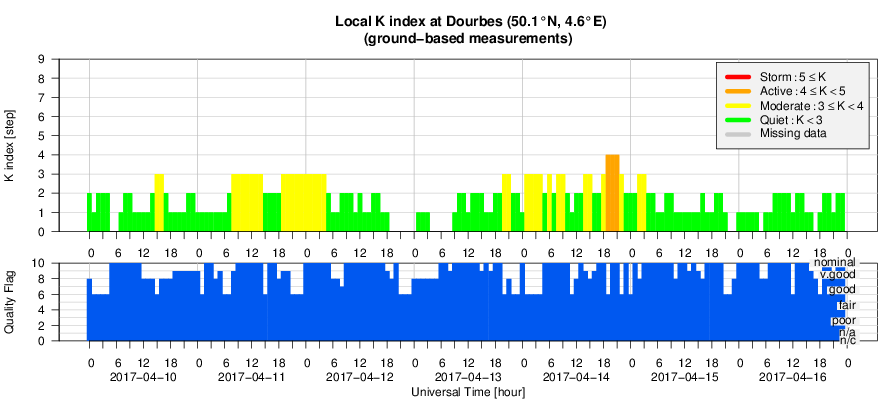- Table of Content
- 1.Impressive sol...
- 2.PROBA2 Observa...
- 3.Review of sola...
- 4.The Internatio...
- 5.Geomagnetic Ob...
- 6.Review of iono...
- 7.Future Events
2. PROBA2 Observations (10 Apr 2017 - 16 Apr 2017)
3. Review of solar activity (10 Apr 2017 - 16 Apr 2017)
4. The International Sunspot Number
5. Geomagnetic Observations at Dourbes (10 Apr 2017 - 16 Apr 2017)
6. Review of ionospheric activity (10 Apr 2017 - 16 Apr 2017)
7. Future Events
Impressive solar eruption
On 18 April, an active region rounded the Sun's northeast limb. It was the return of the old sunspot group NOAA 2644, which produced several medium flares at the end of its previous transit early April (see the news item at http://www.stce.be/news/384/welcome.html ). The region got a new name (NOAA 2651), and quickly showed it still had the potential for producing strong flares. Peaking at 20:10UT on 18 April, a long duration C5.5 flare was recorded with NOAA 2651 as its source.
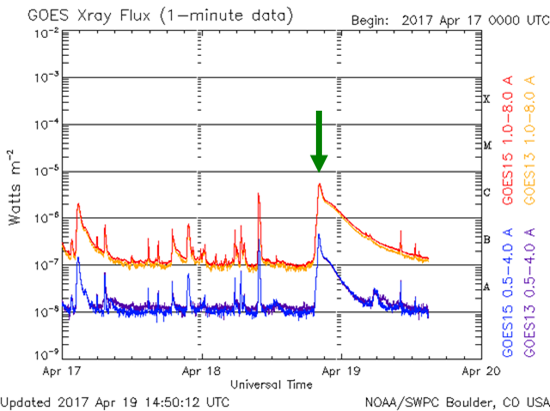
A movie showing the various aspects of this solar eruption can be found at https://youtu.be/7rtsN0CtAeo The first clip shows full disk extreme ultraviolet (EUV) imagery of the event combining images from SDO/AIA171 (temperatures near 700.000 degrees) with the wide-field PROBA2/SWAP174 images (temperatures near 1 million degrees). The location of the event is obvious, as well as the disturbance in the solar corona created by the eruption, and the subsequent development of a series of post-eruption coronal loops ("arcade"). The next movie shows a close-up of this arcade in SDO/AIA171 and the much cooler SDO/AIA304 passband (about 80.000 degrees; reddish). In AIA304, there's an obvious down-streaming of "cool" material along the coronal loops. Also, at their maximum extent, these loops were towering nearly 120.000 km above the solar surface, that's about 10 times the Earth's diameter!
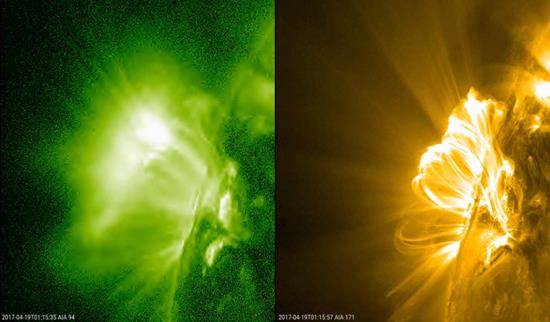
The subsequent clip compares SDO/AIA171 with the much hotter SDO/AIA094 passband (multi-million degrees; greenish). In this passband, the coronal loops are not so well visible, but it shows bright features on top of these loops, the so-called supra-arcade downflows (see this news item at http://www.stce.be/news/331/welcome.html for more info and another example). The AIA094 images complement very well the AIA171 images by showing the ejection of the hot plasma and coronal restructuring. This is highlighted in the next two clips, where these images are stacked upon the wide-field PROBA2/SWAP174 images.
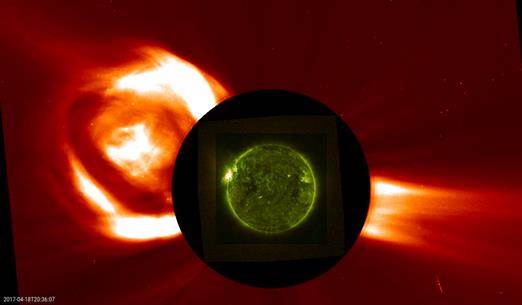
The final two animations show the coronal mass ejection (CME) associated with this C5 flare. Plane-of-the-sky speeds around 750 km/s were calculated from the SOHO/LASCO coronagraph imagery, with the true speeds higher around 900 km/s. There was also a type II radio burst detected, with a deduced shock speed of 1007 km/s. Though the bulk of the CME was directed away from Earth, an impact from the shock around 21 April is possible. As NOAA 2651 is rotating further onto the solar disk, and if the region retains its flaring potential, any associated CME might become a lot more geo-effective.
PROBA2 Observations (10 Apr 2017 - 16 Apr 2017)
Solar Activity
Solar flare activity was very low during the week.
In order to view the activity of this week in more detail, we suggest to go to the following website from which all the daily (normal and difference) movies can be accessed: http://proba2.oma.be/ssa
This page also lists the recorded flaring events.
A weekly overview movie can be found here (SWAP week 368).
http://proba2.oma.be/swap/data/mpg/movies/weekly_movies/weekly_movie_2017_04_10.mp4
Details about some of this week’s events, can be found further below.
If any of the linked movies are unavailable they can be found in the P2SC movie repository here
http://proba2.oma.be/swap/data/mpg/movies/
Monday Apr 10
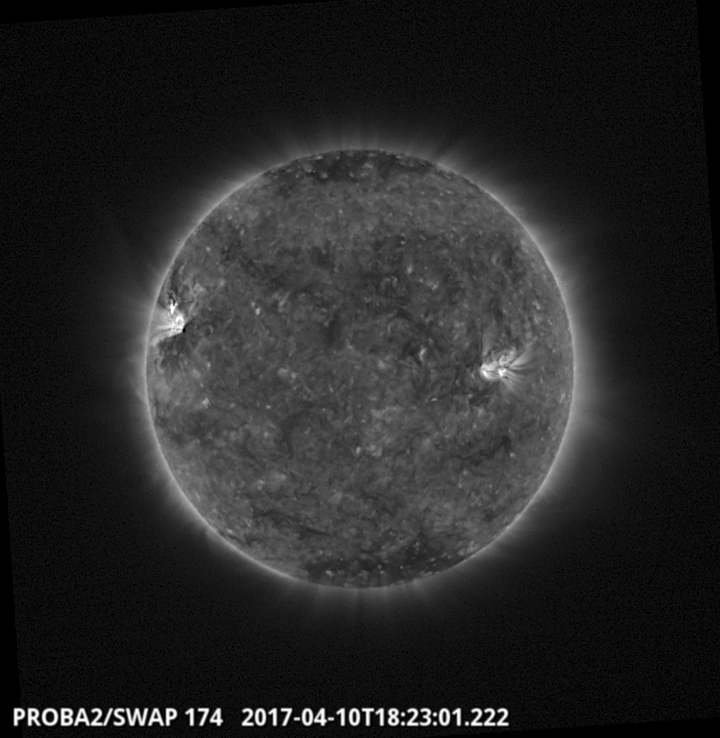
The largest flare of the week was a B4.8 class flare, peaking at 18:23 UT on 2017-Apr-10 produced by the NOAA region 2650, which is visible in the North East Quadrant of the above SWAP image
Find a movie of the events here(SWAP movie)
http://proba2.oma.be/swap/data/mpg/movies/20170410_swap.mp4
Tuesday Apr 11
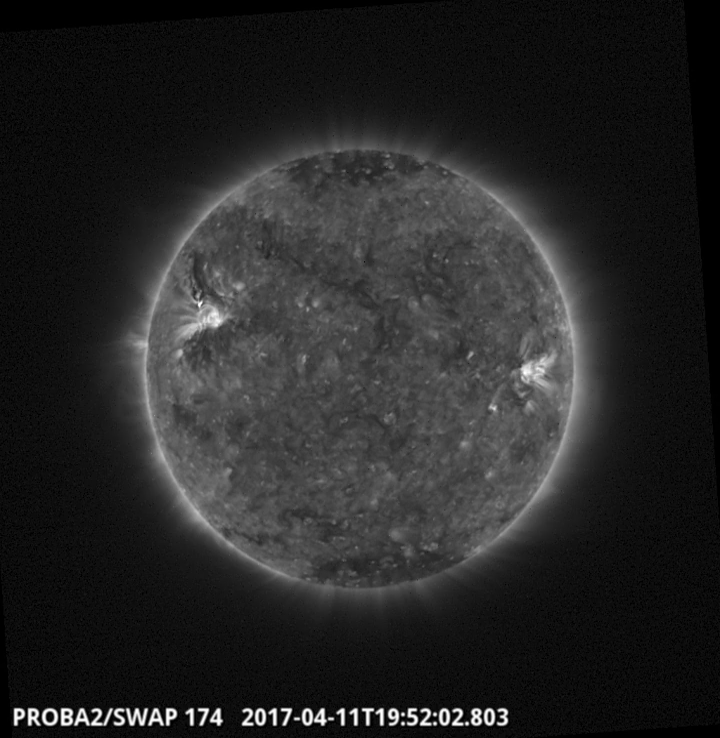
A flare (B1.4 class) followed by a filament eruption was visible in the North East Quadrant of the Sun on 2017-Apr-11 - SWAP image
Find a movie of the events here (SWAP movie)
http://proba2.oma.be/swap/data/mpg/movies/20170411_swap.mp4
Sunday Apr 16
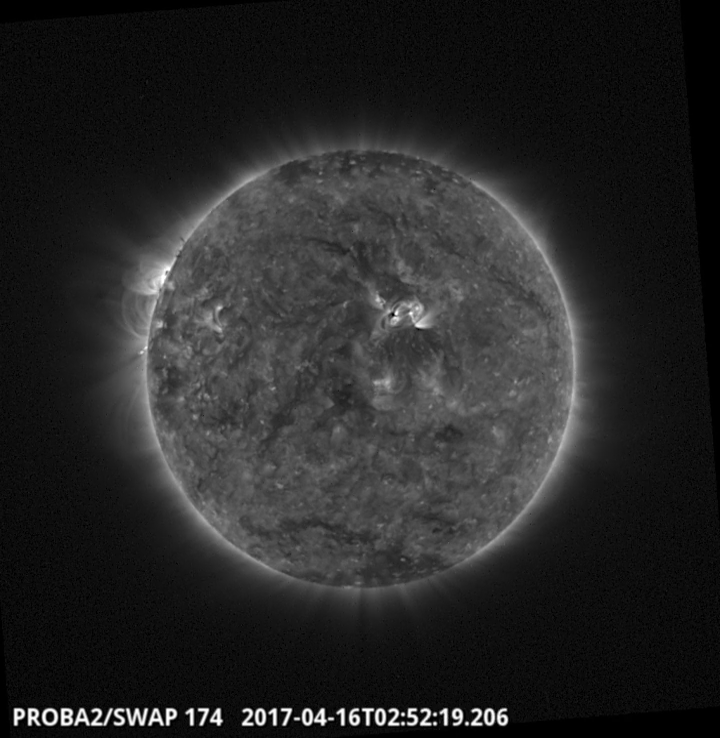
A bright flow associated with a CME was visible on the East Limb of the Sun at 02:52 UT on 2017-Apr-16 - SWAP image
Find a movie of the event here (SWAP movie)
http://proba2.oma.be/swap/data/mpg/movies/20170416_swap.mp4
Sunday Apr 16
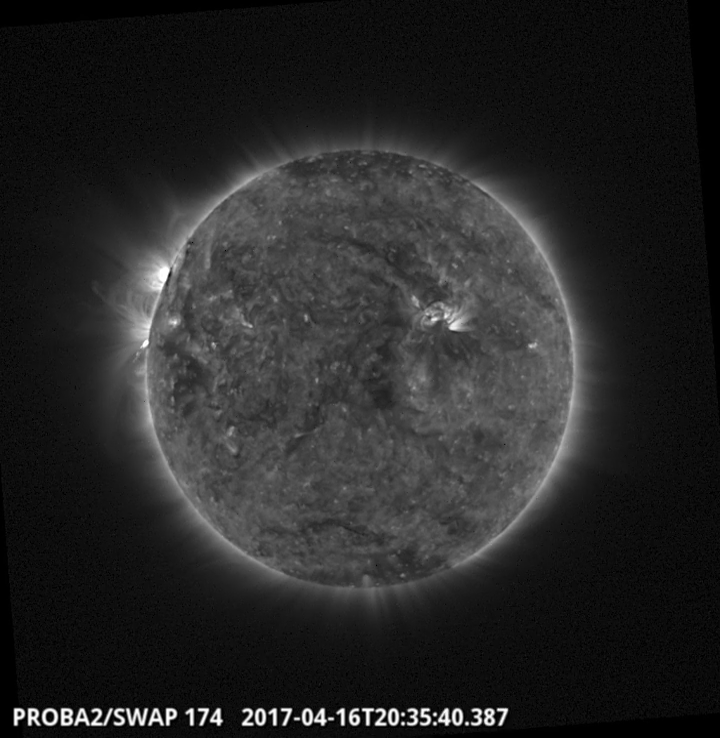
A bright flow erupted on the East Limb at 20:35 UT. It may be the return of NOAA
12644 that produced several M-class flares 2 weeks ago
- SWAP image
Find a movie of the event here (SWAP movie)
http://proba2.oma.be/swap/data/mpg/movies/20170416_swap.mp4
Review of solar activity (10 Apr 2017 - 16 Apr 2017)
Solar Activity
Over the last week solar activity was very low. The GOES X-ray background was below B1 level throughout the week.
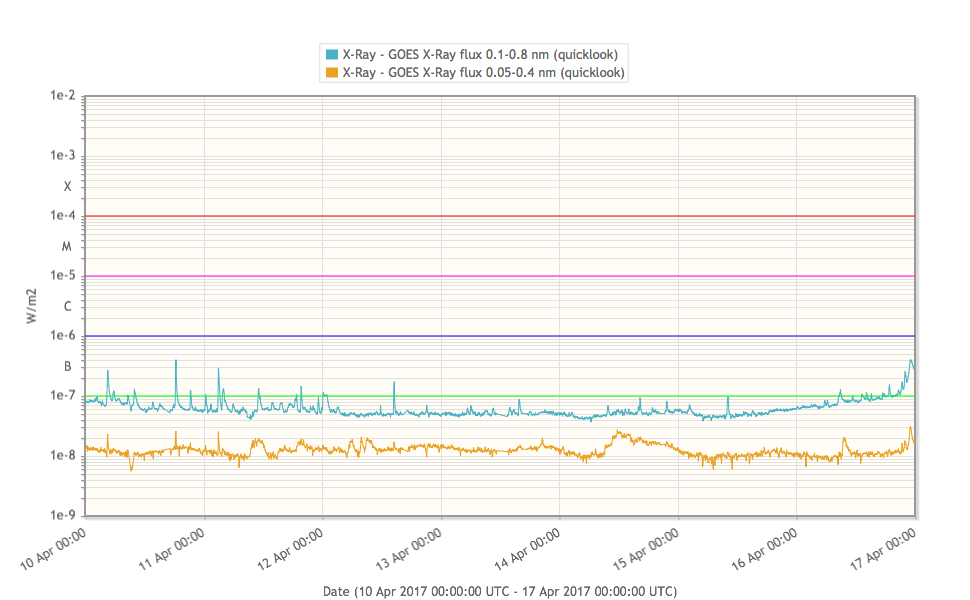
The only region present on the solar disk was NOAA AR 2650, which produced few low B-class flares. Here below a picture of the sunspot associated with NOAA AR 2650 taken by SDO/HMI in the visible light.
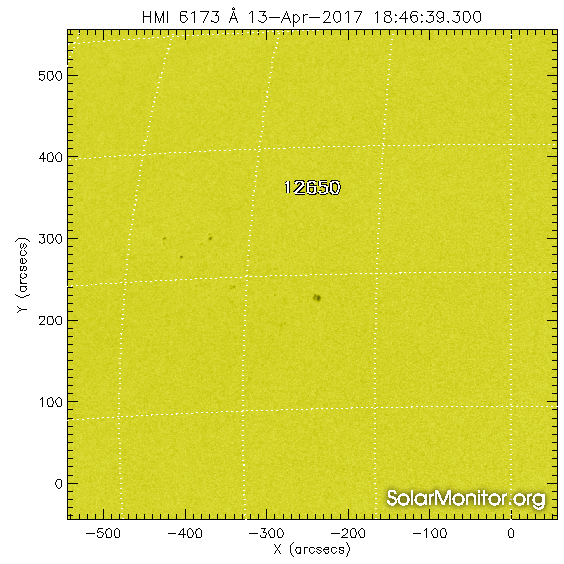
A narrow CME was visible in SoHO/LASCO C2 images from 17:30 UT onwards on April 13. The ejection was mostly directed towards the North West and had an angular extent of approximately 100 degrees. The event was not geoeffective. Integral proton flux for protons with energies above 10 MeV remained at background level.
Geomagnetic Activity
The solar wind speed has fluctuated between 300 and 490 km/s over the past week.
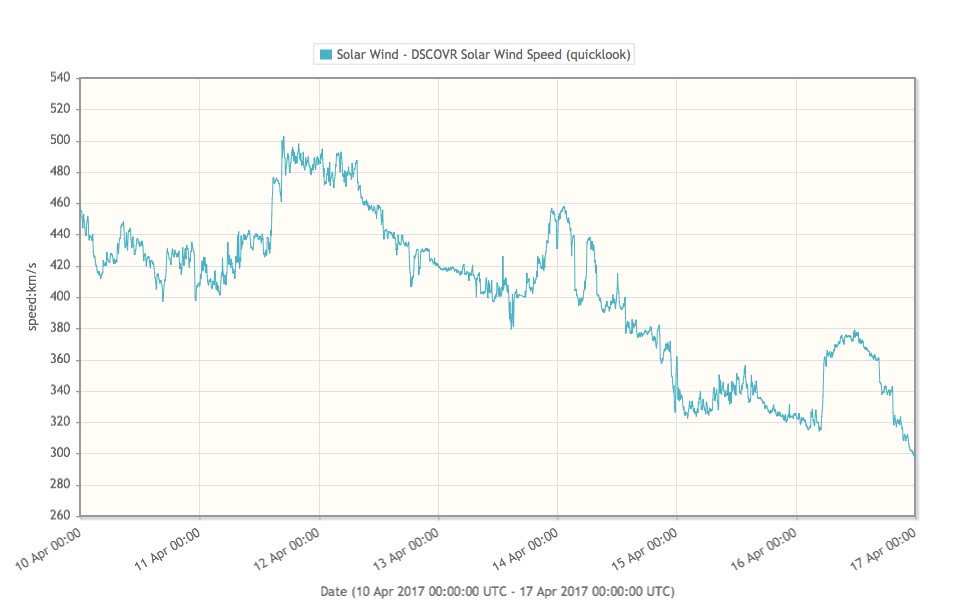
The total magnetic field strength has fluctuated between 3 and 8 nT peaking on April 14. The Bz component fluctuated between -5.8 and +4.5 nT.
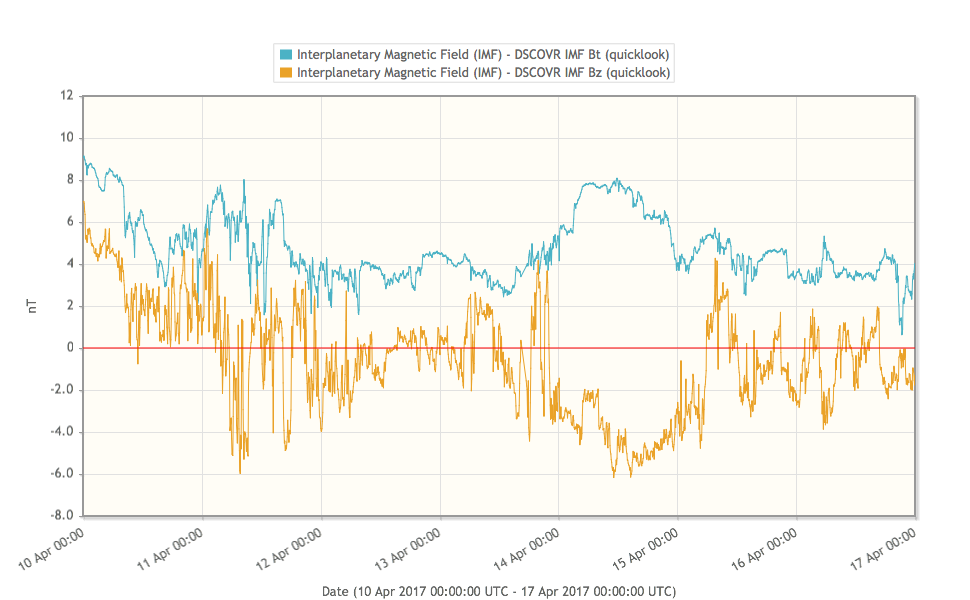
Geomagnetic conditions were mainly between Kp index 0-3 (NOAA) and local K index 0-3 (Dourbes). Isolated episodes of Kp = 4 were observed on April 11 and April 14 in response to elevated solar wind parameters due to the high speed stream coming from the positive polarity low latitude coronal hole as seen in the SDO/AIA image. The coronal hole is drawn on the image, the data comes from the SWEK database.
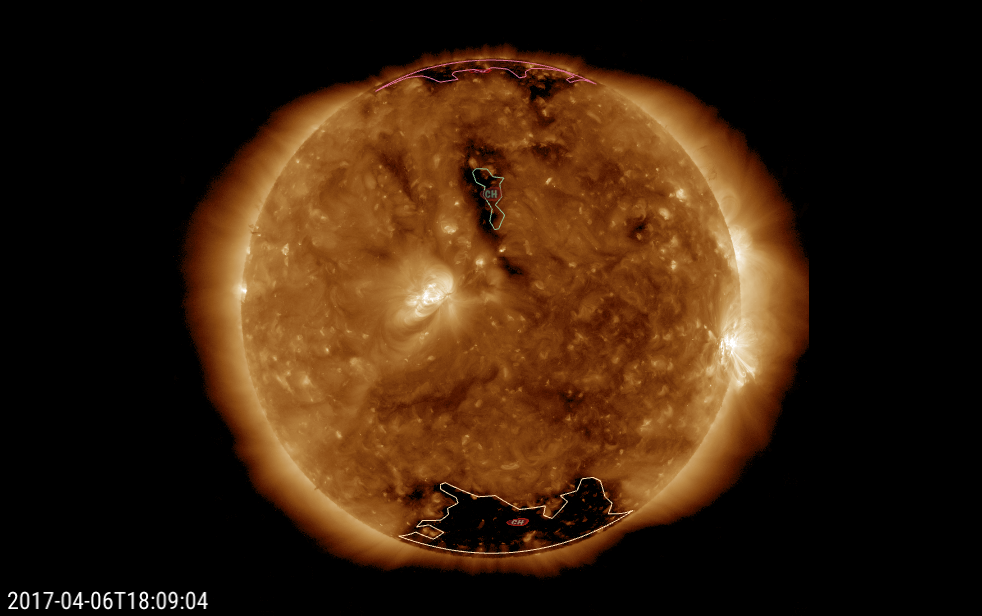
The International Sunspot Number
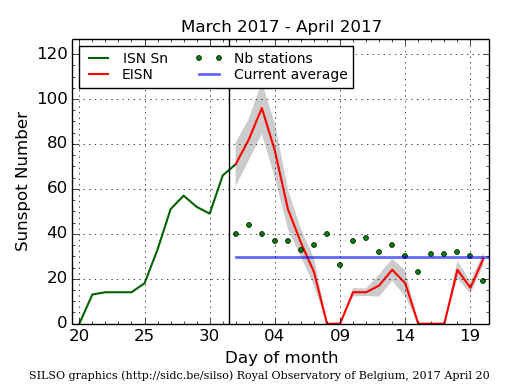
The daily Estimated International Sunspot Number (EISN, red curve with shaded error) derived by a simplified method from real-time data from the worldwide SILSO network. It extends the official Sunspot Number from the full processing of the preceding month (green line). The plot shows the last 30 days (about one solar rotation). The horizontal blue line shows the current monthly average, while the green dots give the number of stations included in the calculation of the EISN for each day.
Review of ionospheric activity (10 Apr 2017 - 16 Apr 2017)
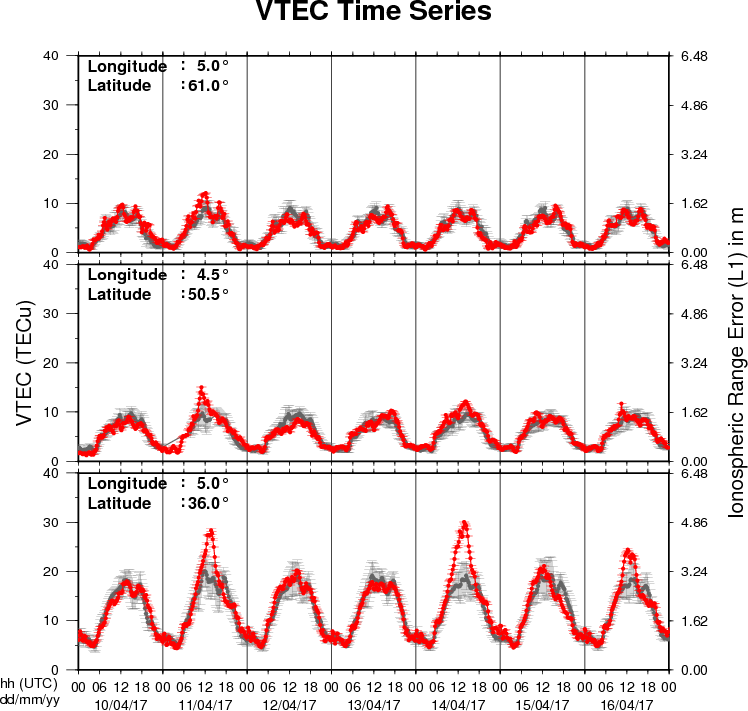
The figure shows the time evolution of the Vertical Total Electron Content (VTEC) (in red) during the last week at three locations:
a) in the northern part of Europe(N61°, 5°E)
b) above Brussels(N50.5°, 4.5°E)
c) in the southern part of Europe(N36°, 5°E)
This figure also shows (in grey) the normal ionospheric behaviour expected based on the median VTEC from the 15 previous days.
The VTEC is expressed in TECu (with TECu=10^16 electrons per square meter) and is directly related to the signal propagation delay due to the ionosphere (in figure: delay on GPS L1 frequency).
The Sun's radiation ionizes the Earth's upper atmosphere, the ionosphere, located from about 60km to 1000km above the Earth's surface.The ionization process in the ionosphere produces ions and free electrons. These electrons perturb the propagation of the GNSS (Global Navigation Satellite System) signals by inducing a so-called ionospheric delay.
See http://stce.be/newsletter/GNSS_final.pdf for some more explanations ; for detailed information, see http://gnss.be/ionosphere_tutorial.php
Future Events
For more details, see http://www.spaceweather.eu/en/event/future
URSI General Assembly in Montreal, Canada
Start : 2017-08-19 - End : 2017-08-26
For the thirty-second time since the inception of URSI, Radio
Scientists from across the world will get together for the URSI
General Assembly and Scientific Symposium. This triennial gathering
will take place from 19th to 26th of August 2017, in Montreal,
Canada. This conference is a unique opportunity to learn about
recent advances in all fields of Radio Science, as covered by all
ten URSI Commissions.
Among the different sessions, please note:
* 'Radio Science for Space Weather'
Conveners: M. Messerotti, V. Pierrard
* 'Remote Sensing and Modeling of the Earth's Plasmasphere
and Plasmapause'
Conveners: A. M. Jorgensen, V. Pierrard, B. Heilig
The abstract deadline is 30 January 2017
Website: http://www.ursi2017.org
2017 Joint IAPSO-IAMAS-IAGA Assembly in Cape Town, South Africa
Start : 2017-08-27 - End : 2017-09-01
The Joint IAPSO-IAMAS-IAGA Assembly, endorsed by the University
of Cape Town and the South African Department of Science and
Technology, will take place from 27 August to 1 September 2017 at
the Cape Town International Convention Centre (CTICC). Several IAGA
and IAMAS sessions are of Space Weather interests as well as the
joint session 'Space Weather throughout the Solar System: Bringing
Data and Models together'.
Website:
http://iapso-iamas-iaga2017.com/index.php
Workshops on Radiation Monitoring for the International Space Station in Torino, Italy
Start : 2017-09-05 - End : 2017-09-07
The Workshop on Radiation Monitoring for the International Space
Station is an annual meeting to discuss the scientific definition
of an adequate radiation monitoring package and its use by the
scientific community on the ISS. Types of instruments and research
topics need to be defined in order to optimise the radiation safety
of the ISS crew.
Website: http://wrmiss.org/
International Workshop on Solar, Heliospheric & Magnetospheric Radioastronomy in Meudon, France
Start : 2017-11-06 - End : 2017-11-10
Jean-Louis Steinbeg has been one of the major pioneers in
radioastronomy. Co-founder of the Nançay Observatory, he
has actively participated to, an inspired a large number of radio
instruments on many international space missions. Jean-Louis
Steinberg is the founder of the Space Radioastronomy laboratory of
the Paris Observatory in 1963. Later on, this laboratory widened
its science interests and became the DESPA (1971) and then the
current LESIA (2002) which is one of the major space sciences
laboratories in France. The aim of this workshop is to cover the
science topics which Jean-Louis Steinberg has promoted during his
career, focusing on Solar, Heliospheric & Magnetospheric
radioastronomy & physics. This will be done by covering both
observations from either ground facilities (NDA, RH, LOFAR, Artemis
etc ...) or space missions (ISSEE, Ulysses, WIND, CLUSTER, STEREO,
CASSINI, JUNO etc ...) and models/theories. A series of invited
talks is also foreseen to cover the new developments in the
discipline which may come with the future facilities such as Solar
Orbiter, Solar Probe Plus, JUICE, JUNO, LOFAR+, SKA etc ....
This workshop will also be the opportunity to remember both the
extraordinary personal & professional lifes of Jean-Louis
Steinberg especially for new generation of scientists. At the
occasion of this workshop it is also expected that the Building 16
(historical Space Sciences building) on the Meudon campus will be
renamed "Building Jean-Louis Steinberg".
Website:
https://jlsworkshop.sciencesconf.org/
European Space Weather Week 14
Start : 2017-11-27 - End : 2017-12-01
The ESWW is the main annual event in the European Space Weather
calendar. It is the European forum for Space Weather as proven by
the high attendance to the past editions. The agenda will be
composed of plenary/parallel sessions, working meetings and
dedicated events for service end-users. The ESWW will again adopt
the central aim of bringing together the diverse groups in Europe
working on different aspects of Space Weather.
Website:
http://www.stce.be/esww14/
